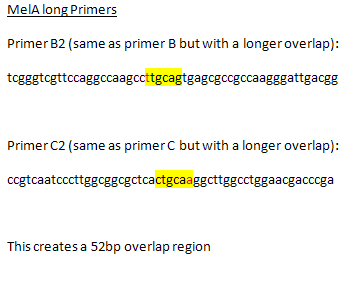Team:Cambridge/Notebook/Week8
From 2009.igem.org
(→Wet Work) |
(→Wet Work) |
||
| Line 68: | Line 68: | ||
[[Image:Longer_primers.PNG]] | [[Image:Longer_primers.PNG]] | ||
| + | |||
| + | ====Final Product Design==== | ||
| + | |||
| + | Thinking about out final product, we decided that for long term product use and transport, it would be best to have the bacteria, and the media, in dry form, activated by adding liquid. We previously looked into anhydrobiotics which, while not feasible for us in the short span of the iGEM competition, would nevertheless be a viable way of storing and transporting the bacteria. In order to test whether the media could also be used in this way we added 2.5g of ''E. coli'' FastMedia (TM) from InvivoGen to 250ml of cold sterilised water, added bacteria and left at 37 degrees in a shaking incubator overnight. | ||
{{Template:CambridgeNewPage}} | {{Template:CambridgeNewPage}} | ||
Revision as of 09:37, 4 September 2009
Categories :
Project :
-
Overview
Sensitivity Tuner
--- Characterisation
--- Modelling
Colour Generators
--- Carotenoids (Orange/Red)
--- Melanin (Brown)
--- Violacein (Purple/Green)
The Future
Safety
Notebook :
Team Logistics :
Week 8
Monday
Wet Work
Threshold device
Transformed 72, 92, 94, and 95 in pSB3K3 into arabinose strain.
Melanin Biobrick
Did the last stage of PCR for the Melanin Biobrick creation. Fragments AB and CF were added with primers A and F and the Finnzymes enzyme, then run on a CYBR-safe gel. The results showed smears rather than bands. As the CF fragment was a little dodgy on the first extraction it was decided to re-extract and try again.
The CF band was reproduced and extracted in the afternoon, creating more CF fragment stock.
Dry Work
Tuesday
Wet Work
Threshold device
Successfully moved 70, 71, 72, 74, 91 into pSB3K3. That makes all 15 activator constructs yay!
Melanin Biobrick
Re-tried the PRC using the new CF fragment under the same PCR conditions. Still getting smeared bands.
Dry Work
Wednesday
Wet Work
Melanin Biobrick
Looked up the possible reasons for smeared bands after PCR, three main ones discovered:
- Too much template DNA
- Incorrect salt concentration
- Comtaminated PCR mix
Nanodropped the fragments and diluted AB 1/10 to get the recommended DNA concentration, and used new pipettes and Primer aliquots. Two tubes were made up using a new Finnzymes mix, and two using the old one.
The gel still showed smears! For all the samples.
Violacein Characterisation
Incubated 20ml LB with violacein and 20ml LB with Top10 control cells in 50ml falcons for characterisation using the plate reader.
Thursday
Wet Work
Melanin Biobrick
Talked with Jim Ajioka about the gel smears after the Melanin PCR. he suggested re-ordering Primers B and C with a longer overlap region, which would make the fragments easier to stick together. In view of this, new primers were designed (shown below):
Final Product Design
Thinking about out final product, we decided that for long term product use and transport, it would be best to have the bacteria, and the media, in dry form, activated by adding liquid. We previously looked into anhydrobiotics which, while not feasible for us in the short span of the iGEM competition, would nevertheless be a viable way of storing and transporting the bacteria. In order to test whether the media could also be used in this way we added 2.5g of E. coli FastMedia (TM) from InvivoGen to 250ml of cold sterilised water, added bacteria and left at 37 degrees in a shaking incubator overnight.
 "
"
